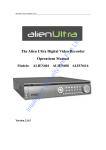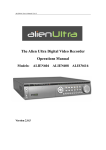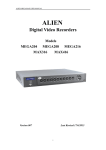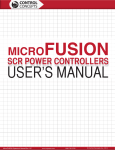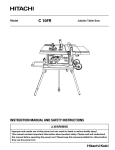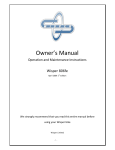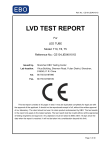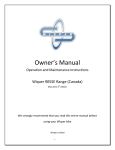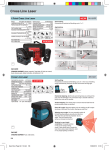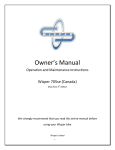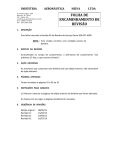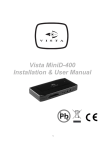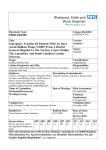Download ALIEN316 User Manual - Astra Security Systems
Transcript
The Alien EKO Digital Video Recorder Operations Manual Models: ALIEN304 Models: ALIEN308 ALIEN316 ALIEN324 ALIEN328 ALIEN330 Special Features: Simultaneous VGA, Main Composite & Spot Outputs1FPS background recording switching to 25FPS on motion detection Multi-Screen Playback on all channels Networking & Email facility Version 1.0.2 Last Revised 12/07/2011 Safety Warnings and Precautions Please pay attention to the following warnings and cautions: Power Supply Hazardous Voltage: AC mains voltages are present within the power supply assembly. This device must be connected to an approved, enclosed power supply of the proper rated voltage and current. No user serviceable parts inside the power supply. System Grounding (Earthing): To avoid shock, ensure that all AC wiring is not exposed and that the earth grounding is maintained. Ensure that any equipment to which this device will be attached is also connected to properly wired grounded receptacles and are approved devices. Power Connect and Disconnect: The AC power supply cord is the main disconnect device to mains (AC power).The socket outlet shall be installed near the equipment and shall be readily accessible. Installation and Maintenance: Do not connect/disconnect any cables or perform installation/maintenance on this device during an electrical storm. Lithium Battery: This device contains a Lithium Battery. There is a risk of explosion if the battery is replaced by an incorrect type. Dispose of used batteries according to the vendor’s instructions and in accordance with local environmental regulations. 1 Preventive and Cautionary Tips Before connecting and operating your DVR, please be advised of the following tips: • Ensure unit is installed in a well-ventilated, dust-free environment. • Unit is designed for indoor use only. • Keep all liquids away from the DVR. • Ensure environmental conditions meet factory specifications. • Ensure unit is properly secured to a rack or shelf. Major shocks or jolts to the unit as a result of dropping it may cause damage to the sensitive electronics within the unit. • Use the DVR in conjunction with a UPS if possible. • Power down the unit before connecting and disconnecting accessories and peripherals. • A factory recommended HDD should be used for this device. • Improper use or replacement of the battery could result in battery explosion. Replace with the same or equivalent type only. Dispose of used batteries according to the instructions provided by the battery manufacturer. 2 Contents Page No Safety Warnings and Precautions Preventive and Cautionary Tips Contents 1. Introduction 1.1 Overview 1.2 Product Features 1.3 Product Application Diagram 1.4 Operating Your DVR 1.5 Using the Front Panel Controls ALIEN324/328/330 ALIEN304/308/316 1.6 ALIEN304/324 Rear Panel 1.7 ALIEN308/328 Rear Panel 1.8 ALIEN316/330 Rear Panel 1.9 IR Remote Control 1.10 Using a USB Mouse 1.11 Using the Soft Keyboard 1 2 3 6 6 7 9 9 10 10 11 14 15 16 17 18 19 2. Getting Started 2.1 Starting and Shutting Down Your DVR 2.2 Rebooting and Locking Your DVR 2.3 Using the Setup Wizard 2.4 Setting Time & Date 20 20 20 21 24 3. Live Preview 3.1 Live Preview On-screen Display 3.2 Live Preview Icons 3.3 Live Preview Operation 3.4 Mouse Operation in Live Preview 3.5 Digital Zoom 3.6 Configure Live Preview Display 3.7 Set Camera Order 25 25 25 25 26 26 27 28 4. Record Settings 4.1 Before Record Settings 4.2 Initialising Record Settings 4.3 Scheduling a Recording 4.4 Starting a Manual Recording 4.5 Protect Recorded Files 4.6 Lock/Unlock Recorded Files 4.7 Set HDD to Read-Only 30 30 30 32 33 33 33 34 5. Video Playback 5.1 Playback Interface 5.2 Playback by Search 5.3 Playback in Live Preview Mode 5.4 Playback by System Log 36 36 37 38 39 3 5.5 5.6 Playback Frame-by-Frame Digital Zoom 39 39 6. Backup 6.1 Exporting Files 6.2 Export Video Clips 6.3 Manage Backup Devices 41 41 43 44 7. Alarm Settings 7.1 Motion Detection Alarm 7.2 Sensor Alarm Settings 7.3 Manual Alarm Triggering 7.4 Video Loss Detection 7.5 Video Tampering Detection 7.6 Exception Settings 7.7 Understanding Exception Triggers 45 45 48 51 51 53 55 55 8. Network Settings 8.1 Configuring Network Settings 8.2 NTP Server Settings 8.3 Remote Alarm Host Settings 8.4 Configuring DVR TCP Ports 57 57 58 59 60 9. PTZ Control 9.1 Navigate PTZ Menu 9.2 Configure PTZ Settings 9.3 Setting PTZ Presets, Patrols & Patterns 9.4 Customising Presets 9.5 Customising Patrols 9.6 Customise Patterns 61 61 61 62 63 64 65 10. Camera Management 10.1 OSD Settings 10.2 Display Settings 10.3 Privacy Mask Settings 67 67 67 68 11. HDD Management 11.1 Initialising HDDs 11.2 Set HDD Groups 11.3 Set HDD Status 11.4 Setting HDD to Read-Only 11.5 Checking HDD Status 11.6 Configure HDD Alarms 70 70 70 71 71 72 74 12. DVR Management 12.1 Configure General Settings 12.2 Configuring Advanced Settings 12.3 RS-232 Port Settings 12.4 Managing User Accounts 12.4.1 Add a New User 75 75 76 76 77 77 4 12.5 12.6 12.7 12.8 12.9 12.4.2 Deleting a User 12.4.3 Modifying a User Importing & Exporting Configuration Updating System Firmware Restore Default Settings View System Information View System Log 80 80 81 81 83 83 84 13. Appendix 13.1 Glossary 13.2 1fps background recording switching to 25fps in CIF 13.3 Record Timings for Alien316/330 13.4 Record Timings for Alien308/328 13.5 Record Timings for Alien304/324 13.6 Frame Rate Settings and TCP Connections for EKO Series 86 86 87 89 90 91 92 14. Frequently Asked Questions 93 15. Specifications 94 All specifications are approximate. Aliendvr.com reserves the right to change any product specifications or features without notice. Whilst every effort is made to ensure that these instructions are complete and accurate, Aliendvr.com cannot be held responsible in any way for any losses, no matter how they arise, from errors or omissions in these instructions, or the performance or non-performance of the equipment that these instructions refer to. This symbol on the products and/or accompanying documents means that used electronic equipment must not be mixed with general household waste. For treatment, recovery and recycling please return this unit to your trade supplier or local designated collection point as defined by your local council. WEE/CG0783SS 5 1. Introduction 1.1 Overview Developed on the basis of the latest technology, the Alien EKO range of Digital Video Recorder combines the latest in advanced H.264 video encoding and decoding technologies delivering high performance, reliability and longer recording times. The Alien EKO Digital Video Recorder can be used as a standalone video surveillance product, as well as the ability to build a powerful surveillance network making it is perfect for home or business applications. ALIEN324/328/330 EKO DVR ALIEN304/308/316 EKO DVR 6 1.2 Product Features Compression PAL/NTSC adaptive video inputs. H.264 video compression with high reliability and superior definition. OggVorbis audio compression standard. Independent video encoding parameters, including frame rate, resolution, bit rate, video quality, etc. Scheduled and event recording parameters configurable for per individual camera. Dual stream support. Encoding for both audio/video composite stream and video stream; audio and video synchronisation during composite stream encoding. Compression, storage and network transmission of video images at 4CIF, 2CIF or CIF resolution. Local Monitoring Up to 1024×768 resolution for VGA output display. Simultaneous VGA and CVBS output. 1/4/9/16-camera video live view, with the camera order adjustable. Group switch, manual switch and automatic cycle modes selectable for video live view, with the auto cycle period configurable. Digital zoom in live view mode. Privacy masking capability. Multiple PTZ protocols supported, and settings and call up of presets, patrols and patterns. Video image zoom-in by clicking the mouse and dragging mouse in PTZ control mode. Hard Disk Management Connection to 1 SATA HDD for with up to 2TB storage capacity. DVD writer uses one SATA connection. Can replace with additional HDD. S. M. A. R. T technology. HDD standby function. Recording Cycle and non-cycle recording mode. Scheduled and event video encoding parameters. Multiple recording types, including manual, continuous, alarm, motion, motion | alarm and motion & alarm recording, etc. 8 recording time periods with separate recording types. Pre-record and Post-record time for alarm and motion detection, and pre-record time for schedule and manual recording. Lock and unlock of video files. HDD property can be set to read-only. Video data search and playback by channel number, recording type, time etc. Digital zoom function in playback mode. Pause, play fast, play slow, skip forward, and skip backward when playback, locating in progress bar by dragging the mouse. 7 Up to 4/8/16-channel playback depending on model. Backup Record files backed up via USB or SATA device. Select backup by file or by time. Record files edited for backup in playback. Management and maintenance for backup devices. Alarm & Exception Configurable arming time for alarm in/out. Various alarm types supported: alarms for video loss, motion detection, video tempering, video in/out format unmatched, illegal access, network disconnection, IP conflict, hard disk error and hard disk full. Various alarm response actions supported: camera recording, relay out, on-screen warning, audible warning and upload to center, etc. Auto recovery from exceptions. Other Control of DVR via front panel keys, mouse, and IR remote control. Three-level user management, each user with individual operating permission for DVR and camera. Powerful record and search for log of operation, alarm and exceptions. Import/export of device configuration files. Network 10/100M adaptive network interface. TCP/IP & network protocols for the UK include SADP, DHCP & NTP Unicast and multicast supported; TCP and UDP protocols applicable in unicast transmission. Remote search, playback and download, lock/unlock of video files. Support breakpoint resume. Remote access and configuration of parameters; remote import/export of device configuration parameters. Remote access of device running status, system log and alarm status. Remote control of DVR via button operation. Remote lock/unlock of panel buttons and mouse. Remote formatting of hard disk, upgrade, reboot/shutdown and other system maintenance operations. RS-232 and RS -485 transparent channel transmission. Event alarm and exceptions upload to remote management host. Remote manual recording. Remote video image capture in JPEG format. Remote PTZ control. Voice talk and broadcast. Built-in WEB Server. 8 1.3 Product Application Diagram Figure 6. Product Application Diagram 1.4 Operating Your DVR There are numerous ways to navigate and operate your DVR. You may use the Front Panel Controls, the included IR (Infrared) Remote, a Mouse or a Soft Keyboard. 9 1.5 Using the Front Panel Controls ALIEN324/328/330 EKO Front Panel 1. READY: the indicator lights in green when the device is running normally. 2. STATUS: the indicator lights when the compound key switches to numeric/letter input mode. 3. ALARM: the indicator lights in red when there is sensor alarm occurring. 4. RECORD: the indicator lights in green when the unit is under recording. 5. NETWORK: the indictor flickers in green when network connection is functioning normally. 6. Control Buttons: • Directional buttons: In menu mode, the direction buttons are used to navigate between different fields and items and select setting parameters. In playback mode, the Up and Down buttons are used to speed up and slow down record play, and the Left and Right buttons are used to select the recording 30s forwards or backwards. In preview mode, these buttons can be used to cycle through channels. • Enter: The Enter button is used to confirm selection in menu mode; or used to select checkbox fields and ON/OFF switch. In playback mode, it can be used to play or pause the video. In single-frame play mode, pressing the Enter button will advance the video by a single frame. And in auto sequence preview mode, the buttons can be used to pause / resume auto sequence. 7. IR Receiver: Operation by IR remote control. 8. MENU: (1) Enter numeral “1”; (2) Access the main menu interface. 9. 2ABC/F1: (1) Enter numeral “2”; (2) Enter letters “ABC”; (3) The F1 button when used in a list field will select all items on the list. In PTZ Control mode, it will turn on/off PTZ light. 10. 3DEF/F2: (1) Enter numeral “3”; (2) Enter letters “DEF”; (3) The F2 button is used to cycle through tab pages. It will also bring up the Channel & OSD position settings. 10 11. 4GHI/ESC: (1) Enter numeral “4”; (2) Enter letters “GHI”; (3) Exit and back to the previous menu. 12. 5JKL/EDIT: (1) Enter numeral “5”; (2) Enter letters “JKL”; (3) Delete characters before cursor; (4)Select the checkbox and ON/OFF switch; (5) Start/stop record clipping in playback. 13. 6MNO/PLAY: (1) Enter numeral “6”; (2) Enter letters “MNO”; (3) Playback, for direct access to playback interface. 14. 7PQRS/REC: (1) Enter numeral “7”; (2) Enter letters “PQRS”; (3) Manual record, for direct access to manual record interface; manually enable/disable record. 15. 8TUV/PTZ: (1) Enter numeral “8”; (2) Enter letters “TUV”; (3) Access PTZ control interface. 16. 9WXYZ/PREV: (1) Enter numeral “9”; (2) Enter letters “WXYZ”; (3) Multicamera display in preview. 17. 0/A: (1) Enter numeral “0”; (2) switch between input methods (upper and lowercase alphabet, symbols and numeric input). 18. SHIFT: Switch of compound keys between the numeric/letter input and functional control. 19. Power On/Off/LED: Press and hold the button to turn off the device. The indicator lights in green when DVR is powered up. 20. USB Interface: Connects USB mouse or USB flash memory devices. ALIEN304/308/316 EKO Front Panel 1. POWER Button: The POWER button is used for power on or power off the DVR. Note: It is important to note that you must click the EDIT button on either the remote or front panel on a text field before you are able to edit its content. After entering text, you must hit the ENTER button to be able to move on to the next field. 2. Ready: Ready indicator turns green when DVR is functioning properly. 3. Status: Status indicator turns green when DVR is controlled by an IR remote. 11 4. Alarm: Alarm indicator turns red when a sensor alarm is detected. 5. Record: Record indicator blinks red when data is being read or written to HDD. 6. NETWORK: NETWORK indictor blinks blue when network connection is functioning properly. 7. MENU Button: The 1/MENU button works as numeric [1]. Pressing this button will return the user to the Main menu (after successful login). The 1/MENU button will also bring up Sensitivity Interface settings. 8. 2ABC/F1: The 2ABC button works as numeric [2] and letter [ABC]. When it is used in a list field will select all items on the list. 9. 3DEF/F2: The 3DEF button works as numeric [3] and letter [DEF]. It is also used to cycle through tab pages. 10. 4GHI/ESC: The 4GHI/ESC button works as numeric [4] and letter [GHI] is also used to escape to the previous menu 11. 5JKL/EDIT: The 5JKL/EDIT button works as numeric [5] and letter [JKL]. The 5JKL/EDIT button is used to edit text fields. When editing text fields, it will also function as a Backspace button to delete the character in front of the cursor. On checkbox fields, pressing the EDIT/IRIS+ button will tick the checkbox. In Playback mode, it can be used to generate video clips for backup. 12. IR Sensor: Used to control DVR 13. JOG SHUTTLE Control: The JOG SHUTTLE control can be used to move the active selection in a menu. The inner ring will move the selection up and down; the outer ring will move it left and right. In the Playback mode, the outer ring is used to jump 30s forward/backward in video files. The inner ring can be used to speed up/slow down the video. In Preview mode, it can be used to cycle through different channels. 14. USB Port: Universal Serial Bus (USB) port for additional devices such as USB mouse and USB Hard Disk Drive (HDD). 15. DVD/CD Writer Tray: Button to open writer tray. 16. PLAY/6MNO: The PLAY/6MNO button works as numeric [6] and letter [MNO]. It is used to enter the Playback menu. It is also used to turn audio on/off in the Playback menu. 17. REC/7PQRS: The REC/7PQRS button works as numeric [7] and letter [PQRS]. It is also used to enter the Manual Record interface. 18. PTZ/8TUV: The PTZ/8TUV button works as numeric [8] and letter [TUV]. It is also used to enter the PTZ Control mode. 12 19. PREVIEW/9WXYZ: The PREVIEW/9WXYZ button works as numeric [9] and letter [WXYZ]. It is also used to switch between single screen and multi-screen mode. 20. A/0: The A/0/ button works as numeric [0]. It is also used to switch between input methods (upper and lowercase alphabet, symbols and numeric input). It can also be used to clear entire masked areas, such as in the Motion Detection and Privacy Mask menus. 21. SHIFT: The SHIFT button is used for switch button action between numeric button and control button. 22. Direction/Enter Buttons DIRECTION Buttons: The DIRECTION buttons are used to navigate between different fields and items in menus. In Playback mode, the Up and Down button is used to speed up and slow down recorded video. The Left and Right button will jump 30s backward and forward in a video. In Preview mode, these buttons can be used to cycle through channels. ENTER Button: The ENTER button is used to confirm selection in any of the menu modes. It can also be used to tick checkbox fields. In Playback mode, it can be used to play or pause the video. In Single Play mode, pressing the ENTER button will advance the video by a single frame. 13 1.6 ALIEN304/324 Rear Panel No. 1 2 3 4 5 6 7 8 9 10 11 12 13 Item VIDEO IN VIDEO OUT Description BNC connectors for analogue video input VIDEO OUT1 is main video out, and VIDEO OUT2 is spot video out AUDIO IN RCA connectors for analogue audio input LINE IN RCA connector for audio input AUDIO OUT RCA connector for audio output LAN Connector for LAN (Local Area Network) VGA DB15 connector for VGA output. Display local video output and menu USB Connector for USB devices RS-232 Interface DB9 connector for RS-232 devices. ALARM IN Connector for alarm input ALARM OUT Connector for alarm output RS-485 Interface Connector for RS-485 devices. T+, T- pin connects to PTZ 12V 12VDC power supply GND Ground(needs to be connected when DVR starts up) POWER Switch for turn on/off the device 14 1.7 ALIEN308/328 Rear Panel No. 1 2 3 4 5 6 7 8 9 10 11 12 13 Item MAIN VIDEO OUT SPOT VIDEO OUT VIDEO IN AUDIO IN LINE IN AUDIO OUT VGA Description BNC connectors for main video out BNC connectors for spot video out BNC connectors for analogue video input RCA connectors for analogue audio input RCA connector for audio input RCA connector for audio output DB15 connector for VGA output. Display local video output and menu RS-232 Interface DB9 connector for RS-232 devices. LAN Connector for LAN (Local Area Network) USB Connector for USB devices ALARM IN Connector for alarm input ALARM OUT Connector for alarm output RS-485 Interface Connector for RS-485 devices. T+, T- pin connects to PTZ 12V 12VDC power supply POWER Switch for turn on/off the device GND Ground(needs to be connected when DVR starts up) 15 1.8 ALIEN316/330 Rear Panel No. 1 2 3 4 5 6 Item MAIN VIDEO OUT SPOT VIDEO OUT VIDEO IN AUDIO IN LINE IN AUDIO OUT VGA 7 8 9 10 RS-232 Interface LAN USB RS-485 Interface 11 ALARM IN ALARM OUT 12V POWER GND 12 13 14 Description BNC connectors for main video out BNC connectors for spot video out BNC connectors for analogue video input RCA connectors for analogue audio input RCA connector for audio input RCA connector for audio output DB15 connector for VGA output. Display local video output and menu DB9 connector for RS-232 devices. Connector for LAN (Local Area Network) Connector for USB devices Connector for RS-485 devices. T+, T- pin connects to PTZ Connector for alarm input Connector for alarm output 12VDC power supply Switch for turn on/off the device Ground(needs to be connected when DVR starts up) 16 1.9 IR Remote Control Your DVR may also be controlled with the IR remote control, shown below. Batteries (2×AAA) must be installed before operation. IR Remote Control The keys on the remote control closely resemble the ones found on the front panel, including: 1. POWER: Turn on/off DVR. 2. DEV: Enable/Disable Remote Control. 3. Alphanumeric: Same as Alphanumeric buttons on front panel. 4. EDIT: Same as JKL/EDIT button on front panel. 5. A: Same as 0/A button on front panel. 6. REC: Same as 7PQRS/REC button on front panel. 7. PLAY: Same as 6MNO/PLAY button on front panel. 8. INFO: Reserved. 9. VOIP: Same as 2ABC/F1 button on front panel. 10. MENU: Same as 1/MENU button on front panel. 11. PREV: Same as 9WXYZ/PREV button on front panel. 12. DIRECTION/ENTER Buttons: Same as DIRECTION/ENTER buttons on front panel. 13. PTZ: Same as 8TUV/PTZ button on front panel. 14. ESC: Same as ESC button on front panel. 17 15. RESERVED: Reserved. 16. F1: Same as 2ABC button on front panel. 17. PTZ CONTROL Buttons: Buttons to adjust the iris, focus and zoom of a PTZ camera. 18. F2 Button: The F2 button is used to cycle through tab pages. It can also be used to enter the Channel &OSD Position settings. Aim the remote control at the IR receiver located at the front of the unit to test operation. If there is no response: 1. Using the front control panel or the mouse, go into Menu > Settings > General > More Settings. 2. Check and remember DVR ID Number. The default ID is 255. This ID is valid for all IR remote controls. 3. Press the DEV button on the remote. 4. Enter the DVR ID Number from step 2. 5. Press the ENTER button on the remote control. If the Status indicator on the front panel turns green, the remote control is operating properly. If the Status indicator does not turn green and there is still no response from the remote, please check the following: 1. 2. 3. 4. 1.10 Batteries are installed correctly and the polarities of the batteries are not reversed. Batteries are fresh and fully charged. IR receiver is not obstructed on DVR. No fluorescent lamp is used nearby. Using a USB Mouse A regular 3-button (Left/Right/Scroll-wheel) USB mouse can also be used with this DVR. To use a USB mouse: 1. Plug USB mouse into one of the USB ports on the front panel of the DVR. 2. The mouse should automatically be detected. The buttons on the mouse corresponds to: 1. Left Button: • Single-Click: Select a component of a menu, such as a button or an input field. This is similar to pressing the ENTER button on the remote/front panel controls. • Double-Click: Switch between single screen and multi-screen mode in Preview/ Playback mode. • Click and Drag: Clicking and dragging the Left mouse button can be used to control the pan/tilt of a PTZ camera as well as to vary the position of digital zoom area and camera OSD. It can also be used to setup the alarm areas. 18 2. Right Button: • Single-Click: Shows pop-up menu. 3. Scroll-Wheel: • Scroll Up: In Preview mode, scrolling up will switch to the previous screen. In Menu mode, it will move the selection to the previous item. • Scroll Down: In Preview mode, scrolling down will switch to the next screen. In Menu mode, it will move the selection to the next item. 1.11 Using the Soft Keyboard When a mouse is used to perform task on the DVR, clicking on a text input field will bring up the Soft Keypad on-screen, as shown in Figure 13. Figure 13. Soft Keypad The buttons on the soft keyboard represents: Lowercase: Designates lowercase input is being used. Uppercase: Designates uppercase input is being used. Switch to Lowercase: Switch to lowercase input. Switch to Uppercase: Switch to uppercase input. Number: Designates number input is being used Symbols: Switch to symbols input. Backspace: Delete the character in front of the cursor. Enter: Confirm selection. ESC: Exit out of Soft Keyboard. Figure 14. Soft Keyboard Buttons 19 2. Getting Started 2.1 Starting and Shutting Down Your DVR Correct startup and shutdown procedures are crucial for extending the life of your DVR. To start your DVR: 1. Please make sure the input voltage meets the requirements of the DVR. 2. Please make sure the VGA port on the rear panel has been connected to a display device or the VIDEO OUT port to a composite monitor, or else no prompt message will be displayed on screen after device startup and the menu operation is inaccessible as well. 3. If the POWER indicator on the front panel does not light, please apply power to the device to start it. After the power has been connected, the POWER indicator will light green and the startup window will appear: To shutdown the DVR: 1. Enter the Shut Down menu, shown in Figure 1 by clicking on Menu > ShutDown. Figure 1. Shutdown Menu 2. 3. Select the ShutDown button. Click the Yes button. 2.2 Rebooting and Locking Your DVR While in the Shutdown menu (Figure 1), you may also reboot or lock your DVR. Locking your DVR will return you to the Live Preview mode, which will require a user name and password to exit out of it. The Reboot button will reboot your DVR. To reboot or lock your DVR: 1.Enter the Shutdown menu by clicking Menu > ShutDown. 2.Select the Lock button to lock the DVR or the Reboot button to reboot the DVR. 20 2.3 Using the Setup Wizard Note: Please ensure the DVR has been installed with HDD before access to the Setup Wizard. By default, the Setup Wizard will start once the DVR has loaded, as shown in Figure 2. The Setup Wizard will guide you through some important settings of your DVR. Select Next if the DVR has been installed with HDD, or click Cancel to access Live View window if no HDD is installed. Note: If the checkbox is changed to , then the Setup Wizard dialog box will not appear next time until the factory default settings are resumed; and if you select the checkbox as , the device will automatically access the Setup Wizard dialog box when it starts up next time. Figure 2. Setup Wizard To start using the Setup Wizard: 1. Click the Next button on the Wizard window. This will take you to the User Permission window, shown in Figure 3. Figure 3. User Permission 21 2. Navigate to the Admin Password text box. 3. Type the admin password into the Admin Password text box. By default, the password is 12345. 4. To change the admin password, check the New Admin Password checkbox. Type new password and confirm it in the given text boxes. 5. Click Next button to enter the HDD Management dialog box, shown in Figure 4. Figure 4. HDD Management 6. To access HDD management interface, click the Enter button. 7. If a new HDD has been recently installed, select the HDD from the list to initialise it. Initialising the HDD will format and remove all data on it. 8. After the HDD has been initialised, click the OK button which will take you back to the Setup Wizard window. 9. Click Next button to enter the Record Settings dialogue box, as shown in Figure 5. 22 Figure 5. Record Settings 10. To access Record Settings interface, click the Enter button. See 13.6 Frame Rate Settings and TCP Connections For EKO Series. 11. Select the Schedule tab, shown in Figure 6. Figure 6. Schedule Settings 12. Click Edit button to enter a new recording schedule, shown in Figure 7. 13. Check both the Enable Schedule and All Day checkbox. This will enable the recording schedule and make it record continuously all day. 23 Figure 7. Edit Schedule Settings 14. Click the OK button. This will take you back to the Schedule tab. To copy the schedule to a different channel, select the channel or all under Copy To and click the Copy button. 15. Click Next button to access the Network Settings dialog box, shown in Figure 8. Figure 8. Network Settings 16. To configure network settings, click the Enter button. 17. Enter the IP Address, Subnet Mask and Default Gateway settings. 18. Click OK button to return to the Setup Wizard. 19. If all the settings have been entered, click Done to finish and exit the Setup Wizard. You’ve completed the Setup Wizard. The next step in the initial setup process is to setup the system date and time. After completion of Setup Wizard, enter the Live View window. 2.4 Setting Date & Time It is extremely important to setup the system date and time to accurately timestamp recordings and events. Figure 9. General Settings 1. Open the Menu window by clicking the MENU button on the remote or front panel. You can also go to the Menu window by right clicking with the mouse and clicking the Menu button. 2. Click the Settings icon. 3. Click the General icon. 4. Enter date and time in System Time. 5. Click Apply then OK to save. 24 3. Live Preview 3.1 Live Preview On-screen Display The Live Preview mode is automatically started after the DVR boots up. It is also at the very top of the menu hierarchy, thus hitting the ESC multiple times (depending on which menu you’re on) will bring you to the Live Preview mode. 3.2 Live Preview Icons Some icons are provided on screen in Live Preview mode to indicate different camera and monitor status. These icons include: Main Output Aux Output Event Alarm: Indicates video loss, video tampering, motion detection or relay alarm. Record: Indicates the current channel is recording. The recording may have been started manually, from a schedule, and/or triggered from motion or alarm. Event Alarm & Record Figure 1. Live Preview Icons 3.3 Live Preview Operation In Live View mode, you can operate the following functions: 1. Display Single Camera: • By Front Panel/Remote: Use Alphanumeric buttons. • By Mouse: Select Single Camera in right-click menu. 2. Multi-camera Preview: • By Front Panel/Remote: Press PREV button. • By Mouse: Select Multi Camera in right-click menu. 3. Manual Switch: • By Front Panel/ Remote: Press the Left arrow button to access the 25 previous screen; press the Right arrow button to access next screen. • By Mouse: Select Next Screen in right-click menu. 4. Auto Sequence: • By Front Panel/Remote: Press Enter button. • By Mouse: Select Start Auto-switch in right-click menu. 5. Digital Zoom: • By Mouse: Select Digital Zoom in right-click menu. 3.4 Mouse Operation in Live Preview Some functions of the Live Preview can be quickly accessed by clicking the right-button of the mouse (shown in Figure 2). These functions include: • Single Camera: Switch to a full-screen display of the selected camera by drop-down submenu. • Multi Camera: Switch between different multi-camera display modes by drop-down submenu. • Next Screen: When displaying less than the maximum number of cameras in Live Preview, select this option to switch to the next camera display. • Playback: Enter Playback mode of the selected camera. • PTZ: Enter PTZ Control mode of the selected camera. • Digital Zoom: Enter Digital Zoom interface of the selected camera. • Menu: Enter Main menu. • Start Auto-switch: Enable multi-camera sequence in Live Preview mode. Note: The dwell time of the preview configuration should be set before using Start Auto-switch function. Figure 2. Live Preview Mouse Menu 3.5 Digital Zoom To use digital Zoom in Live Preview mode: 1. Right-click the mouse in Live Preview mode. 2. Select Digital Zoom from drop-down submenu. 3. Left-click and drag the red box to the desired area for zooming. The zoomed image will be magnified by 4 times. An example is shown below. 26 Figure 3. Digital Zoom 3.6 Configure Live Preview Display Click Menu >Settings >Display to access the Live Preview display settings: Figure 4. Display Settings Configure the following settings for Live Preview Display: • • • • • • • Video Output: Set the video output modes, including VGA, Aux Output and Main CVBS. Mode: Set the live view display mode to be 1×1, 2×2, 3×3, or 4×4. Dwell Time: Set the dwell time for camera switching when Start Auto-switch is selected in Live Preview. Camera Order: Set the camera order for display in the selected mode (See Setting Camera Order). Enable Audio Output: Enable/disable audio output for the selected video output. Event Output Port: Set the port for event output to be VGA, Main CVBS or Aux Output. Event Dwell Time: Set the dwell time for event video display. Note: 1. This DVR will automatically detect whether a VGA monitor is connected or not. 2. When a VGA monitor is connected to the DVR, then the VGA will be used as the 27 main video output, and all menu operations are accessible by mouse, front panel or IR remote. The VIDEO OUT 1 will be used as the spot video output which only allows a user to access the live view of the camera according to the configured CVBS video parameters and the VIDEO OUT 2 will be used as the auxiliary video output, which allows user to access the single-camera live view of the camera as well as press the 3DEF/F2 button on the front panel to switch the camera display. 3. When there is no VGA display connected to DVR, the VIDEO OUT1 will be used as the main video output, and menu operations are accessible; the VGA will be used as the spot video output which only allows user to access the live view of the camera according to the configured VGA video parameters; and the VIDEO OUT2 is used as the auxiliary video output which allows user to access the single-camera live view of the camera as well as press the 3DEF/F2 button on the front panel to switch the camera display. 4. The connection or disconnection of the VGA monitor when running will not affect its functions as detailed above. DVR VGA Connections MULTI - MENU VGA main No VGA MULTI - NO MENU VGA Spot MULTI = multi-screen display MENU = Menu available VID OUT 1 SPOT MULTI -NO MENU MULTI - MENU MULTI - MENU VID OUT 2 AUX SINGLE – NO MENU SINGLE – NO MENU SINGLE – NO MENU SINGLE = single screen display NOTE: VID OUT 2 AUX only provides single screen display but is switchable. 3.7 Set Camera Order The Camera Order settings allow you to set camera sequence in selectable live view display mode. See the following figure: Figure 5. Camera Order Settings 28 Operate the following steps to set camera order: 1. Enter the Display Settings menu (Menu > Settings > Display) and click Set in the Camera Order item. 2. Select the video output port and the display mode (1×1, 2×2, 3×3 and 4×4 modes selectable). 3. Use the direction buttons on front panel to move to the display pane for setting then press the Enter button to confirm the selection. 4. Use the direction buttons on front panel to select the camera you want to view in the display pane. The option ‘×’ indicates no camera display. 5. Press Enter button to confirm the selection. 29 4. Record Settings There are multiple ways to setup your DVR for recording. They include setting up a recording schedule, triggering a recording by motion detection and/or a sensor alarm, and manually starting the recording. 4.1 Before Record Settings Before configuration, please make sure your DVR has been installed with an HDD and has completed its initialisation, otherwise, access Menu > HDD Management to install the HDD and perform initialisation first. Note: Please refer to Initialising HDD for specific instructions for initialising HDD. 4.2 Initialising Record Settings 1. Click Menu > Settings > Record to access the Record Settings dialogue box, shown in Figure 1. Figure 1. General Record Settings 2. 3. • • • • • • • 4. Select the camera you want to configure. Configure the following settings: Encoding Parameters: Set the encoding parameters to be Normal or Event. To setup Ramp Up facility refer to section 13.2 Stream Type: Set the stream type to be Video or Video & Audio. Resolution: Set recording at resolution of 4CIF, 2CIF, CIF or QCIF. For more information see section 13.6 Bit Rate Type: Set the bit rate type to be Variable or Constant. Video Quality: Set the video quality of recording, with 6 levels configurable. Frame Rate: Set the frame rate of recording. For more information see sections in Chapter 13. Max Bit Rate: Select or customise the maximum bit rate for recording. Click the Set button under More Settings to configure more recording settings, as shown in Figure 2. 30 Figure 2. More Record Settings • Pre-Record: Set the time in seconds to pre-record before the actual • • • 5. 6. 7. recording begins. Post-Record: Set the time in seconds to post-record after the actual recording has ended. Recording Expired Time: Set the expiration time in days for recorded video. Recorded files after expiration time will be deleted. Set to ‘0,’ to disable this function but note that the actual period for record file storage is determined overall by the available HDD space. Record Audio: Enable or disable audio record for the selected camera. Click OK to finish settings and return to the previous menu. Press the 3DEF/F2 button on DVR front panel to select the Advanced tab to access the Advanced Settings submenu, shown in Figure 3. Enable or disable the Overwrite setting. Enabling the Overwrite setting will cause recorded files to be overwritten once the HDD is full. Click Apply and then OK to return to the previous menu. Figure 3. Advanced Record Settings 31 4.3 Scheduling a Recording The Schedule allows you to set up flexible recording schedules for daily or weekly recording. To set up a recording schedule: 1. Click Menu > Settings > Record to enter the Record Settings menu. 2. Select the Schedule tab to enter the Schedule dialogue box, shown below. Figure 4. Scheduling a Recording 3. 4. 5. 6. Select Camera you want to configure recording schedule. Click the Edit button to enter the Schedule Settings dialogue box. Click and check Enable Schedule checkbox. Select the day you want to set up the schedule or select All Week to record for entire week. 7. Click All Day to enable recording for entire day, or select different periods for each day. Up to 8 time periods can be scheduled. Note: The time periods must be in order and must not overlap. 8. Select recording Type. Recording type can be selected to scheduled or triggered by motion detection and/or alarm. For more specific settings about motion detection and alarm recordings, please refer to Configuring Alarms. 9. Click the OK button to finish configuration. 10. Repeat Steps 3-9 for other cameras or copy settings from one schedule to the others under the Copy To option. 11. Click OK to finish configuration and save the schedule settings. Note: The Event encoding parameters will take effect when motion detection or alarm triggers and the Timing encoding parameters will take effect when there are no events happening. 32 4.4 Starting a Manual Recording A manual recording can be enabled at any time by means of the following configuration: 1. Press the REC button on the front panel to access the Manual Record dialogue box, shown in Figure 5. Figure 5. Manual Record Menu 2. Start manual recording by selecting ON or OFF for each camera. NOTE: The manual option overrides any schedule operation. 4.5 Protect Recorded Files Two methods are provided to prevent recorded files from being deleted from the HDD or overwritten during cycle recording: set the recorded files to be locked or set the HDD that the files reside on to read-only. 4.6 Lock/Unlock Recorded Files To lock or unlock a recorded file: 1. Click Menu > Video Search to enter the Video Search dialogue box, shown in Figure 6. Figure 6. Video Search Menu 33 2. Search for desired recording by entering search parameters. Search parameters include Camera ID, Video/File Type, and Start/End Time. 3. Click the Search button. A list of recorded files (see Figure 7) matching the search parameters will be displayed. 4. Select the file you want to lock/unlock. 5. Click the Lock button to lock file. If the file is already locked, click the Unlock button to unlock file. Locked files will be shown with a closed lock while unlocked files, opened lock. 6. Click Cancel to exit the Video Search menu. Figure 7. Video Search Result List 4.7 Set HDD to Read-Only To set a HDD to read-only: 1. Click Menu > HDD to access the HDD Management dialogue box, shown in Figure 8. Figure 8. HDD Management Menu 34 2. 3. 4. Select the General tab. Select the HDD to set to read-only. Click the Property button to enter the Property Settings dialogue box, shown in Figure 9. Figure 9. HDD Property Settings Menu 5. Set HDD Status to Read-only and then click OK to finish the setting. Note: 1. Once set to read-only, the HDD cannot be written to until it is set back to read/write (R/W). 2. If the DVR is installed with one HDD only, when the property is set to read-only, the recording to the device will stop. 35 5. Video Playback The Client application allows all users to play back recorded files for a specified period. Multi-camera simultaneous playback on all channels is supported. 5.1 Playback Interface Multiple toolbar and buttons are provided on the playback interface to control the video playback. Refer to the following figure: 16-11-2009 Mon 11:55:19 Playback Panel Playback Control Panel Figure 1. Playback Interface The Playback Control Panel, as shown in Figure 2, provides various control buttons for video playback. Audio On/Off Start/Stop Clip Previous File/Day Next File/Day Backward 30s Time Line Slow Forwrd Pause Stop Record Type Line Quit Playback Hide Panel Fast Forwrd Forward 30s Figure 2. Playback Control Panel Note: A blue bar refers to the Normal recording (scheduled, manual), while the red bar indicates Event recording. 36 5.2 Playback by Search To play back record files by video search: 1. Enter the Video Search menu by clicking Menu > Video Search. 2. Set the search parameters by selecting cameras to search, video/file type and the start/end time (as shown in Figure 3). Figure 3. Video Search Menu 3. Click the Play button on the front panel to start playback of all the files found, or click the Search button to access the list of search results. After search results are presented, select the file you want to play back and press the Play button. 4. Record files will automatically be played back in the Playback interface, shown in Figure 4. Figure 4. Playback Interface 37 5.3 Playback in Live Preview Mode The Client application also allows you to play back record files in Live Preview mode. To play back by channel in Live Preview mode: Using a Mouse: 1. Right-click the mouse on desired channel and select the Playback option. 2. Record video from the selected channel will start playing back in the Playback window. An Attention message will appear if there are no recordings found in the previous 5 minutes. 3. You may also select additional channels for playback from the channel list on the right side of the Playback interface, as shown in Figure 5. Figure 5. Playback Interface Using the Front Panel/Remote: 1. Press the PLAY button on front panel to access the Playback mode. 2. Enter the channel you want to view record video from the front panel or remote control (i.e. press ‘SHIFT’, the STATUS light will turn green, then press ‘01’ for channel 1, press ‘02’ for channel 2). 3. Recordings will start for the selected channel. Note: the record video for playback is of the previous 5 minutes. Multi-camera Playback 1. Select the cameras from the camera list you want to have simultaneous playback. 2. Click to stop the ongoing video playback. 3. Click to start multi-camera simultaneous playback. Note: Up to 16 cameras can be played back simultaneously. 1. The camera list operation is accessible by mouse only. Please do not operate by front panel. 2. If the camera numbered the lowest among the multiple cameras selected for simultaneous playback provides no recorded files for the current day selected from the calendar, then the warning message “Playback failed” will be displayed on the screen. 38 3. The video for simultaneous playback by multiple cameras selected from the camera list refers to the all-day recorded files of the selected day. 5.4 Playback by System Log To play back video from the System Log: 1. Click Menu > Maintenance > Log Search to enter the Log Search dialogue box, shown in Figure 6. Figure 6. Log Search Menu 2. Set Major Type to Information; set Minor Type to Start Record or End Record; and then select the Start Time and End Time as well. 3. Click the Search button. A list of search results will be displayed. Select the video log and click Play to play back. 4. The selected recording then will begin to play in the Playback interface. 5.5 Playback Frame-by-Frame To play back frame-by-frame in the Playback interface: Using a Mouse: 1. Click the Slow Forward button on the Playback Control Panel until the speed changes to Single frame. 2. Click the Pause button to advance the video frame by frame. Using the Front Panel/Remote Control: 1. Press the Down button to select the playback speed to Single frame. 2. Press the Enter button to advance the video frame by frame. 5.6 Digital Zoom To use digital zoom in Playback mode: 1. Right click the mouse in Playback mode. 2. Select Digital Zoom from drop-down submenu. 39 3. Left click and drag the red box to the desired area for zooming. The zoomed image will be magnified by 4 times. An example is given in the following figure: Figure 7. Digital Zoom in Playback Mode 40 6. Backup Recorded files can be backed up to various devices, such as USB flash drives, USB HDDs or a DVD writer. 6.1 Exporting Files To export record files: 1. Click Menu > Video Export to enter the Export Video menu, shown in Figure 1. Figure 1. 2. 3. 4. Export Video Select desired parameters to search for files to export. On the toolbar, press the Export button to enter the Record Backup menu. Select the files to export, as shown in Figure 2. You may also click the Play button to confirm the record file you want to export. Figure 2. Video Search Results 41 4. The size of the currently selected file/s is displayed in the lower-left corner of the window. Click the Next button to enter the Export menu, shown in Figure 3. Figure 3. 5. 6. Select device to which the record file is exported from drop-down list (USB Flash Drive, USB HDD, DVD Writer). If backup device is not recognised: • Click the Refresh button. • Reconnect device. • Check for compatibility from vendor. Click Start to begin backup process, shown in Figure 4. Figure 4. 7. Export Menu Backup Progress After the backup process has completed (Figure 5), you may select the files from your device and click the Play button to verify that it has been exported successfully. 42 Figure 5. Export Successful Screen Note: Video Player software will automatically be copied on to the device that the recorded files were exported on. 6.2 Export Video Clips You may also select video clips to export directly in Playback status. A maximum of 30 clips can be selected for each channel. To export video clips during Playback: Using the Mouse: 1. Enter the Playback interface (See Video Playback). 2. Click the Clip Start/Stop button on the Playback Control Panel, and select the start and end of the video clip during playback. 3. Repeat for additional clips. 4. Click the Quit Playback button to exit from the Playback interface. You’ll then be prompted to save the clips, as shown in Figure 6. Figure 6. 5. 6. Video Clips Saving Prompt Click the Yes button to enter Backup interface or select No to exit Playback interface. At the Backup interface, select the Start button to begin the Backup process. 43 Using the Front Panel / Remote: 1. Enter the Playback interface (See Video Playback). 2. During playback, press the EDIT button to mark start of clip. 3. Press the EDIT button again to mark end of clip. 4. Repeat for additional clips. 5. Press the ESC button to exit from the Playback interface. You’ll then be prompted to save the clips, as shown in Figure 6. 6. Click the Yes button to enter Backup interface or select No to exit Playback interface. 7. At the Backup interface, select the Start button to begin the Backup process. 6.3 Manage Backup Devices To manage backup devices, you must first be in the Export menu, shown in Figure 7. The Export menu can be accessed by following the steps shown in the previous section (See Exporting Files). Figure 7. Export Menu Once in the Export menu, you may: • • • • • Create New Folder: Creates a new folder on the export device. Delete: Delete a file or folder from the export device. Play: Play the selected video file from the export device. Format: Format the export device. Erase: Erase files from a re-writable CD/DVD. 44 7. Alarm Settings 7.1 Motion Detection Alarm Operate the following steps to configure Motion Detection Recording: 1. Enter Camera Setting: Click Menu > Settings > Camera to access the Camera Settings menu, as shown in Figure 1. Figure 1. Camera Management Interface 2. Select the Advanced tab to enter the Advanced Camera Settings menu, shown in Figure 2. Figure 2. 3. Advanced Camera Settings Select Motion Detection first and click the Area Settings button to enter the Motion Detection Area and Sensitivity settings interface. 45 4. As shown in Figure 3, the Motion Detection area allows you to mask areas you want to configure motion detection. The maximum area can be set to be full screen. You can left click mouse, hold and drag it to mask the Motion Detection area. Using EDIT button and direction buttons can also help you to select Motion Detection area. Figure 3. 5. Right click mouse or press the MENU button on the front panel to set the Motion Detection Sensitivity, shown in Figure 4. Higher sensitivity value corresponds to higher sensitivity level. Figure 4. 6. 7. 8. Motion Detection Area Motion Sensitivity Settings Click OK to return to the motion detection area settings interface. Right click the mouse to select the Exit from the menu to return to the Advanced Camera Settings menu. Click the Handle button to enter the Exception Handle menu, shown in Figure 5. 46 Figure 5. Triggered Camera Settings 5. Select cameras to trigger for recording when motion is detected by checking the checkboxes under the desired cameras. 6. Select the Schedule tab. Set the schedule you want motion detection to be enabled. Schedule can be set for all week or any day of the week with up to 8 time periods per day. Note: After having configured the schedule, the DVR must be restarted for the new settings to take effect. Figure 6. 7. Schedule Settings Select the Handle tab to configure exceptions handling. Exception trigger options will be described in the next section (See Understanding Exception Trigger Options). 47 Figure7. 8. Handle Settings Click OK to complete motion settings for the selected camera. You may now add a schedule to start recording when motion is detected (See Scheduling a Recording). 7.2 Sensor Alarm Settings Recordings can also be triggered from an external relay alarm device. To set up sensor alarms: 1. Click Menu > Settings > Alarm to enter the Alarm Settings menu, shown in Figure 8. Figure 8. Alarm Management Menu 2. Select the Alarm Input No. and click the Set button to enter the Alarm Input Settings menu, shown in Figure 9. 48 Figure 9. Alarm Management Settings 3. Set the alarm input type to be Normally Opened (N.O) or Normally Closed (N.C). 4. Check the checkbox next to Setting and click the Handle button to enter the Alarm Input Handle menu. 5. Select the Triggered Camera tab. 6. Select cameras to trigger for recording when alarm occurs by checking the checkboxes under the desired cameras, as shown in Figure 10. Figure 10. Triggered Cameras Menu 7. User may select the PTZ camera to link with the alarm input and then set the call up of preset, patrol and pattern for alarm linked actions. 8. Click the OK button to complete setup. You may now add a schedule to start recording when an alarm is triggered (See Scheduling a Recording). 49 Alarm outputs may also be configured in the Alarm Management menu. To set up Alarm Output: 1. Select the Alarm Output tab. This will bring up the Alarm Output interface, shown in Figure 11. Figure 11. Alarm Output Interface 2. Select the output you would like to configure and click the Set button. This will bring up the settings page for the selected channel (Figure 12). Figure 12. Alarm Output Settings 3. Configure the settings for selected output. 4. Select OK to save and exit. Note: If the Hold For option is selected as Manually Stop, the alarm will only stop when you manually stop it (See Triggering Alarm Outputs Manually). 50 7.3 Manual Alarm Triggering You may also trigger alarm outputs manually through the Manual Alarm menu. To trigger alarm outputs manually: 1. Click Menu > Manual Alarm to enter the Manual Alarm menu (Fig. 13). Figure 13. 2. 3. 7.4 Manual Alarm Menu Configure the following settings in the Manual Alarm menu: • Trigger: Select an alarm from the list and click Trigger to trigger its output. • Trigger All: Trigger all alarm outputs at once. • Clear All: Stop all alarm outputs at once. Select OK to return to the previous menu. Video Loss Detection Your DVR can be set up to detect video loss and trigger an action. To set up video loss detection: 1. Click Menu > Settings > Camera to enter Camera Settings menu, shown in Figure 14. Figure 14. Camera Management Menu 51 1. 2. 3. Select the Advanced tab. Select the camera to be configured with video loss detection. Check the Video Loss Detection checkbox to enable this feature, as shown in Figure 15. Figure 15. 5. 6. Camera Settings Menu Click the Handle button to enter the Exception Handle menu, shown in Figure 16. Select the Schedule tab. Set the schedule you want video loss detection to be enabled. Schedule can be set for all week or any day of the week with up to 8 time periods per day. Note: After having configured the schedule, the DVR must be restarted for the new settings to take effect. Figure 16. 7. Schedule Settings for Video Loss Detection Select the Handle tab to configure exceptions handling. Exception trigger options will be described in the next section (See Understanding Exception Trigger Options). 52 Figure 17. Exception Handle Menu 8. 9. Click OK to finish the settings. Repeat above steps to configure settings for other channels. 7.5 Video Tampering Detection The video tampering can also be detected and set to trigger an action on your DVR. Note: The video tampering detection area is in full-screen mode by default and cannot be configured. To set up video tempering detection: 1. Click Menu > Settings > Camera to enter the Camera Settings menu, shown in Figure 18. Figure 18. 2. 3. 4. Camera Management Menu Select the Advanced tab. Select the camera to be configured with video tampering detection. Check the Tamper Detection checkbox to enable this feature, as shown in Figure 19. 53 Figure 17. Camera Settings Menu 5. Click the Handle button to enter the Exception Handle menu, shown in Figure19. 6. Select the Schedule tab. Set the schedule you want video tampering detection to be enabled. Schedule can be set for all week or any day of the week with up to 8 time periods per day. Note: After having configured the schedule, the DVR must be restarted for the new settings to take effect. Figure 20. 7. Schedule Settings for Video Tampering Detection Select the Handle tab to configure exceptions handling. Exception trigger options will be described in the next section (See Understanding Exception Trigger Options). Figure 21. Exception Handle Menu 54 8. 9. Click OK to finish the settings. Repeat above steps to configure settings for other channels. 7.6 Exception Settings The exception setting allows the DVR to alert you when irregular events occur. These events include: • HDD Full: All installed HDD are full. • HDD Error: Errors occurred during writing of the HDD, no HDD installed or HDD had failed to initialise. • Network Disconnected: Disconnected network cable. • IP Conflict: Conflict in IP address setting. • Illegal Login: Incorrect user ID or password used. • Video Output Standard Mismatch: video output standards do not match with each other. To set exceptions: 1. Click Menu > Settings> Exception to enter the Exception menu. 2. Select the exception to configure under Exception Type. 3. Select triggering options, as shown in Figure22. Trigger options are further explained in the next section (See Understanding Exception Trigger Options). Figure 20. Exception Menu 4. Click OK to save settings and exit Exception menu. 7.7 Understanding Exception Trigger Options When setting up exception handlers for such features as motion detection and relay alarms, you may select triggering options to alert you of these exceptions. The triggering options that you may select include: 55 • Pop-up Image on Monitor: When an alarm is triggered, the local monitor (VGA or BNC monitor) will display an image in Live Preview mode. This alarm can be configured under the Popup Alarm Image handle method. For alarms that are triggered simultaneously, images will be displayed one at a time every 10 seconds (default dwell time). A different dwell time can be set by going to Menu > Setting > Display > Dwell Time. Once the alarm stops, cycling of the images will also stop and you’ll be returned to the Live Preview screen. • Audio Warning: Trigger an audible beep when exception is detected. • Notify Surveillance Centre: Sends a signal to remote alarm host when exception is detected (See Configure Remote Alarm Host). • Trigger Alarm Output: Trigger an alarm output when exception is detected. Alarm output can be configured by following the steps listed in Setting up Sensor Alarms. 56 8. Network Settings Network settings must be configured if DVR is used for monitoring over network. 8.1 Configuring Network Settings To configure general network settings: 1. Click Menu > Settings > Network to enter the Network Settings menu, shown in Figure 1. Figure 1. Network Settings Menu 2. Select the General tab. Configure the settings on the interface. 3. If you have a DHCP server running and would like your DVR to automatically obtain an IP address and other network settings from that server, check the DHCP checkbox. You may check the DHCP status by going to the Network Status tab, as shown in Figure 2. Figure 2. Network Status 57 4. 5. If you want to configure your own settings, enter the settings for: • IP Address: IP address you would like to use for your DVR. • Subnet Mask: Subnet Mask of network. • Default Gateway: IP address of your Gateway. Typically the IP address of your router. • Preferred/Alternate DNS Server: The preferred and alternate Domain Name System (DNS) Server to be used with your DVR. Click OK to save settings and exit the Network Settings menu. 8.2 NTP Server Settings A Network Time Protocol (NTP) Server may also be set up on your DVR to maintain accurate current date and time. To set up an NTP server: 1. 2. 3. Click Menu > Settings > Network to enter the Network Settings menu. Select the Advanced tab. Click the Set button next to NTP to enter the NTP Settings menu, as shown in Figure 8. Figure 8. 4. 5. NTP Settings Menu Check the NTP checkbox to enable this feature. Configure NTP settings: • Synchronize Interval: Time in minutes to synchronise with NTP server. • NTP Server: Address of NTP server. Note: The address can be set to the IP address or the Domain name. When the Domain name is used, please set the DNS server address. 6. Click OK to save settings and exit the NTP Settings menu. 58 Note: Time synchronisation interval has a range of 0-10080 min, normally 7200 min. If the DVR is used on a public network, you should use a NTP server that has a time synchronisation function, such as the server at the National Time Center (IP Address: 210.72.145.44). If the DVR is setup in a more customised network, NTP software can be used to establish a NTP server used for time synchronisation. 8.3 Remote Alarm Host Settings With a remote alarm host set, the DVR will send a signal to the host when an alarm is triggered. The remote alarm host must have the CCTVWindow software installed. 1. 2. 3. Enter Network settings menu by clicking Menu > Setting > Network. Select the Advanced tab. Click the Set butt next to Host/Others to enter the Host/Others menu, as shown in Figure 9. Figure 9. 4. Host/Others Menu Enter Alarm Host IP and Alarm Host Port. Alarm Host IP is the IP of the remote PC which has the CCTVWindow software installed. The Alarm Host Port must be the same as software’s alarm monitor port (default port is 7200). Figure 10. Host/Others Menu 5. Click OK to save settings and exit the Host/Others menu. 59 8.4 Configuring DVR TCP Ports If you would like to change the DVR ports from the default settings, you can do so in the Network Settings menu. The default server port is 8000 while the default HTTP port is 80. To change the default ports: 1. 2. 3. 4. Click Menu > Settings > Network to enter the Network Settings menu. Select the Advanced tab. Click the Set button next to Host/Others to enter the Host/Others menu. Enter new Server Port and HTTP Port, as shown in Figure 11. Figure 11. Host/Others Menu Note: The Server Port has a port range of 2000-65535 and is used for remote client software access. The HTTP port is used for remote Internet browser access. 60 9. PTZ Control 9.1 Navigate PTZ Menu PTZ menus can be navigated through with either the mouse or the front panel/remote. For quick access to certain PTZ settings, right clicking with the mouse in a display while in PTZ control mode will enter the PTZ settings menu. This menu is shown in Figure 1. Figure 1. PTZ Settings Menu The items that can be found on this menu include: • • • • • • • • • Camera: Select a PTZ camera. Call Preset: Call a PTZ preset. Call Patrol: Call a PTZ sequence. Call Pattern: Call a PTZ pattern. Preset Settings: Enter PTZ preset configuration menu. Patrol Settings: Enter PTZ sequence configuration menu. Pattern Settings: Enter PTZ pattern configuration menu. PTZ Menu: Enter PTZ control menu. PTZ Settings: Enter PTZ settings menu. 9.2 Configure PTZ Settings Settings for a PTZ camera must be configured before it is used. Before proceeding, verify that the PTZ and RS-485 settings in the DVR are identical and connected properly. The T+ is the RS485 positive (usually connected to the orange RS485 data cable on the PTZ camera) and T- is the RS485 negative (usually connected to the yellow RS485 data cable on the PTZ camera). 61 To configure PTZ settings in DVR: 1. Click Menu > Settings > PTZ to enter the PTZ Settings menu, shown in Figure 2. Figure 2. PTZ Settings Menu 2. 3. Select channel where PTZ camera is installed next to Camera label. Configure the settings of baud rate, data bit*, stop bit*, parity*, flow control*, PTZ protocol and address. * The settings asterisked normally are the defaults for most PTZ cameras. 4. Click OK to save settings and exit the PTZ Settings menu. Note: All setting parameters (baud rate, data bit, stop bit, parity, flow control, PTZ protocol and address) must be consistent with the PTZ camera connected. 9.3 Setting PTZ Presets, Patrols & Patterns The DVR allows you to program presets, patrols and patterns for a range of PTZ cameras. The PTZ control panel provides a series of PTZ controls, shown in Fig. 3. Figure 3. PTZ Control Interface 62 The controls on the PTZ panel include: 1. 2. 3. 4. 5. 6. 7. 8. 9. Directional Pad/Auto-scan Buttons: Controls the movements and directions of the PTZ. The center button is also used to start auto-scan of PTZ. Zoom: Used to zoom in and out with the PTZ. Focus: Used to adjust the focus of the PTZ. Iris: Used to open up or close the iris of the PTZ. Speed: Adjusts the movement speed of the PTZ. Light: Turns PTZ light (if applicable) on and off. Wiper: Turns PTZ wiper (if applicable) on and off. Zoom In: Instantly zooms PTZ in. Center: Centers PTZ. 9.4 Customising Presets Presets can be set to move your PTZ camera to a desired preset location. To set up and call custom PTZ presets: 1. 2. 3. Enter the PTZ Control interface, shown in Figure 3, by selecting PTZ from the mouse menu or clicking the PTZ button on the front panel. Select the Preset button to enter the Preset Management menu. In the Preset Management menu, shown in Figure 4, you may: • Configure Preset: Use the PTZ control panel to adjust the position of the preset. Select a Preset number and click the Set button to save preset location. • Clear Preset: Select a Preset number and click the Clear button to delete the preset. You may also select the Clear All button to delete all presets. • Call Preset: Select a Preset and click the Call button. Figure 4. Preset Management Menu Note: Only valid presets can be called and deleted. Presets are also used to trigger tours. Please refer to PTZ camera manual. 63 9.5 Customising Patrols Patrols can be programmed to move the PTZ to different key points and make it stay there for a defined duration before moving on to the next point. The key points are defined by presets which can be set by following the steps above in Customise Presets. To set up and call PTZ patrols: 1. Enter the PTZ Control interface, shown in Figure 3, by selecting PTZ from the mouse menu or clicking the PTZ button on the front panel. Select the Patrol button to enter the Patrol Management menu, shown in Figure 5. 2. Figure 5. 3. Patrol Management Menu In the Patrol Management menu, you may: Configure a Patrol: 1. Select a Patrol Number to set. 2. Select valid presets (See Customise Presets) and click the Set button to enter the Patrol configuration menu. A sequence should have at least 2 valid presets. 3. Set the Key Point No., Duration, and Speed (Figure 6). The Key Point No. determines the order at which the PTZ will follow while cycling through the patrol. The Duration refers to the time span to stay at the corresponding key point. The Speed defines the rate at which the PTZ will move to the current preset. Figure 6. Patrol Configuration Menu 64 4. Click OK to return to Patrol Management menu and repeat steps 2-3 to configure other key points. 5. After all key points have been configured, click the defined key point No. and then click Add button to complete the settings. 6. Click OK button to save settings and exit the current menu. Clear Patrol: 1. Select a valid Patrol Number. 2. Click the Clear button to delete patrol. Call Patrol: 1. Select a valid Patrol Number. 2. Click the Start button to call the patrol, and select the Stop button to stop the patrol, as shown in Figure 7. Figure 7. Patrol Management Menu 9.6 Customise Patterns Patterns can be setup by recording the movement of the PTZ. To set up and call PTZ patterns: 1. Enter the PTZ Control interface, shown in Figure 3, by selecting PTZ from the mouse menu or clicking the PTZ button on the front panel. 2. Select the Pattern button to enter the Pattern Management menu, shown in Figure 8. Figure 8. Pattern Management Menu 65 3. 4. 5. 6. Select a Pattern Number. To record a new pattern, select the Run Record button to start recording of the movements of the PTZ. Use the PTZ control panel to move the PTZ. The PTZ movements will be recorded until the Stop Record button is clicked. To run a pattern, click the Run Pattern button on a valid pattern. The PTZ will move according to the path that was defined until Stop Pattern is clicked. Click OK to exit the current menu. 66 10. Camera Management 10.1 OSD Settings On Screen Display (OSD) settings can be configured in the Camera Management menu. The OSD is shown in each display during Live Preview mode and includes the time and date as well as the camera name. To configure OSD settings: 1. 2. 3. Click Menu > Settings > Camera to enter the Camera Settings menu, shown in Figure 1. Select channel to set up OSD settings under Channel No., and click the Set button. Configure desired OSD settings, as shown in Figure1. Figure 1. 4. 10.2 OSD Settings Menu Click the Set button to edit the OSD display position, including the camera name position and the date/time display position. Display Settings Display settings such as the brightness, contrast, saturation and hue can also be adjusted in the Camera Management menu. To adjust display settings: 1. Click Menu > Settings > Camera to enter the Camera Settings menu, shown in Figure 1. 2. Click the Advanced tab to enter the Advanced Camera Settings menu, as shown in Figure 1. Select channel for image settings in Camera. 3. Click the Set button next to the Image Settings label. 4. Adjust the display settings, as shown in Figure 3. Brightness, contrast, saturation and hue can be adjusted in the menu. The adjustments of display settings will affect the live images and the recorded images. 67 Figure 3. 10.3 Display Settings Privacy Mask Settings You may setup privacy mask to mask off sensitive or private areas in the field of view of a camera. To setup privacy mask: 1. 2. Click Menu > Settings > Camera to enter the Camera Settings menu. Click the Advanced tab to enter the Advanced Camera Settings menu, as shown in Figure 1. Select channel for privacy mask settings in Camera. Figure 1. 3. 4. 5. Advanced Camera Settings Menu Check the Mask checkbox to enable feature. Click the Area Settings button to enter Area Settings menu. Set mask area, as shown in Figure2. Up to 4 areas can be set. 68 Figure2. 6. Setting Mask Area Select Exit to save settings and exit the Mask Area Settings interface. 69 11. HDD Management 11.1 Initialising HDDs A newly installed hard disk drive (HDD) must be first initialised before it can be used with your DVR. Initialising the HDD will erase all data on it. To initialise a HDD: 1. Click Menu > HDD to enter the HDD Management menu, shown in Figure 1. Figure 1. 2. 3. 4. 11.2 HDD Management Menu Select HDD to be initialised. Click the Init button. Select OK button to start initialisation. After the HDD has been initialised, the status of the HDD will change from Abnormal to Normal. Set HDD Groups Your DVR can separate multiple HDDs into groups. Videos from specified channels can be set to be recorded onto a particular HDD group. To set up an HDD group: 1. 2. 3. 4. Click Menu > HDD to enter the HDD Management menu. Select HDDs to be added to group. Select Group button to enter Group Settings menu. Set the HDD Group Number, as shown in Figure 2. 70 Figure 2. 5. HDD Group Settings Menu Select OK to save settings and exit the Group Settings menu. Note: By default all HDDs belong to group 1. 11.3 Set HDD Status You may change the behavior of your HDD by changing its status. The status of a HDD can be set to read-only or read/write (R/W). 11.4 Setting HDD to Read-Only A HDD can be set to read-only to avoid important recorded files from being overwritten when the HDD becomes full. To set a HDD to read-only: 1. 2. 3. Click Menu > HDD to enter the HDD Management menu. Select HDD to be protected. Select the Property button to enter the Property Settings menu, as shown in Figure 3. Figure 3. HDD Property Settings Menu 71 4. 5. Set HDD Status to Read-Only. Select OK to save settings and exit the current menu. Note: 1. Once set to read-only, the HDD cannot be written to until it is set back to read/write (R/W). 2. If the DVR is installed with one HDD only, if property is set to read-only, the recording of the device will stop. 11.5 Checking HDD Status You may check the status of the installed HDDs on your DVR at anytime. To check the status of a HDD: 1. 2. Click Menu > HDD to enter the HDD Management menu. The status of your HDD is listed under the Status column. If the status is listed as Normal or Hibernate, the HDD is in working order. If it is listed as Abnormal and has already been initialised, the HDD needs to be replaced. If the HDD is Uninitialised, you will need to initialise it before it can be use in your DVR. Please refer to Initialising HDDs for further instructions. You may also view the SMART information of installed HDDs. SMART which is an abbreviation for Self-Monitoring, Analysis and Reporting Technology, is a monitoring system for hard disk drives to detect and report on various indicators of reliability in the hopes of anticipating failures. To view SMART information of a HDD: 3. Click Menu > Maintenance > Log Search to enter the Log Search menu, shown in Figure 4. Figure 4. Log Search Menu 72 4. 5. 6. 7. Set Major Type to Information. Set Minor Type to HDD SMART. Enter Start Time and End Time. Click the Search button to begin log search. A list of results, similar to that of Figure 5, will be returned. Figure 5. Log Search Results 1. Select log item to view and click the Details button. A detail list of SMART information, as shown in Figure 6, will be displayed. Figure 6. HDD SMART Information User can also click Menu > HDD to enter the HDD management menu, as shown in Figure 1 and then select the Advance option to enter the SMART menu, as shown in Figure 7. User can enable the SMART function and view the SMART information as well. 73 Figure 7. 11.6 HDD SMART Menu Configure HDD Alarms HDD alarms can be set to trigger when an HDD is uninitialised or in an abnormal state. To set HDD alarms: 1. Click Menu > Settings > Exception to enter Exception menu, shown in Figure 8. Figure 8. Exception Menu 2. 3. Select HDD Error under Exception Type. Select trigger action. Trigger actions are further explained in Understanding Exception Trigger Options. 74 12. DVR Management 12.1 Configuring General Settings General settings such as the system language can be configured in the General Settings menu of your DVR. To configure general settings: 1. Click Menu > Settings > General to enter the General Settings menu, shown in Figure 1. Figure 1. 2. 3. General Settings Menu Select the General tab. Configure general settings, including: • Language: Default language used in DVR menus. • CVBS Output Standard: Video output standard: NTSC and PAL. • VGA Resolution: VGA output resolution. • Time Zone: Time zone to use for DVR. • Menu Date Format: Format for date. • System Time: System time and date. • Mouse Pointer Speed: Speed of mouse pointer. • Enable Password: Enable/disable system password. Note: If the video standard is different between the input and the output, you may notice flickering in Live Preview mode. After having modified the video standard, please reboot the device to validate the settings. 75 12.2 Configuring Advanced Settings To configure more advanced settings: 1. 2. Click Menu > Settings > General to enter the General Settings menu, shown in Figure 1. Click the More Settings tab to enter the More Settings menu, shown in Figure 2. Figure 2. 3. 12.3 More Settings Menu Configure the following settings: Device Name: Name of the DVR used. Device No.: Device number of DVR. CVBS Output Brightness: Video output brightness. Transparency: Menu transparency. Operation Timeout: Set timeout time for menu inactivity. For example, if timeout time was set to 5 minutes, after 5 minutes of inactivity in the General Settings menu, you’ll be returned to the Live Preview. Output Hint: Enable/disable video output hint for main or aux video output. RS-232 Port Settings Currently the serial port in this device is reserved for engineer’s access so there are no user-supported serial port features at the time of writing. New functionality to the Alien DVR range of devices is being developed and this functionality should be available in the near future. 76 12.4 Managing User Accounts By default settings, your DVR is configured with the user name of admin and the password of 12345. The Administrator has the authority to add, delete or configure the user parameters. 12.4.1 Add a New User To add a new user: Click Menu > Settings > User to enter the User Settings menu, shown in Figure 4. Figure 4. 1. User Settings Menu Select the Add button to enter the Add User menu, shown in Figure 5. Note: Up to 31 users can be added. Figure 5. Add User Menu 77 Enter information for new user, including User Name, Password, Level and User’s MAC. 2. The Level is the user level and is separated into two tiers. Operator: By default, the Operator user level has the authority to configure two-way audio in network settings and all parameters in channel settings. Guest: By default, the Guest user cannot configure network settings, but can configure the local playback as well as the remote playing in channel settings. 3. If User’s MAC is configured and enabled, the user may only access the DVR from that particular MAC address. 4. Select the Permission button to enter the Permission Settings menu, shown in Figure 6. Figure 6. Permission Settings Menu 5. Configure permission for local settings under Local Permission tab. The local settings include: Local Log Search: Search and view logs of DVR. Local Configuration: Configure and restore parameters to factory defaults. Introduce settings to or export settings from DVR. Local Advanced Operation: HDD management (including the initialisation and changing the properties of a disk). Ability to update system firmware as well as to stop the relay output Local Shutdown/Reboot: Shutdown or reboot the DVR. 6. Click on Network Permission tab to configure network permission settings, as shown in Figure 7. The network settings include: Figure 7. Network Permission Settings Menu 78 7. Remote Log Search: Remotely view logs that are saved on the DVR. Remote Configuration: Remotely configure parameters, restore parameters to factory defaults and import settings to as well as export settings from DVR. Remote Serial Port Control: Configure settings for RS232 and RS485 ports. Remote Video Output Control: Configure settings for video output. Two-way Audio: Ability to use two-way radio between the remote client and the DVR. Remote Alarm Control: Remote alert or control the relay output of the DVR. Alarm and exception settings must be configured properly to upload to host. Remote Advanced Operation: Remotely manage hard disk drives (initialising and setting properties for HDDs). Ability to remote update system firmware and stop of the relay output Remote Shutdown/Reboot: Remotely shutdown or reboot the DVR. Click on the Channel Permission tab to configure channel permission, as shown in Figure 8. The channel settings include: Figure 8. 8. Camera Permission Settings Menu Remote Live View: Select and view live video over the network. Local Manual Record: Locally start and stop manual recording on any of the channels. Remote Record Starting: Remotely start and stop manual recording on any of the channels. Local Playback: Locally play recorded files that are on the DVR. Remote Playback: Remotely play and download recorded files that are on the DVR. Local PTZ Control: Locally control PTZ cameras. Remote PTZ Control: Remotely control PTZ cameras. Local Video Export: Locally backup recorded files from any of the channels. Click the OK button to save and exit menu. 79 12.4.2 Deleting a User To delete a user from the DVR: 1. Click Menu > Settings > User to enter the User Settings menu. 2. Select user to delete. 3. Click the Delete button to delete user. 4. Click the OK button to exit menu. Note: No deletion is allowed for the Administrator. 12.4.3 Modifying a User To modify a user: 1. 2. 3. Click Menu > Settings > User to enter the User Settings menu. Select user to modify. Click the Modify button to enter the Modify menu, shown in Figure 9. Figure 9. 4. 5. 6. Modify User Menu Edit user information. To modify user permissions, click on the privileges button. Permissions settings are defined in the Adding a New User section described above. Click the OK button to exit menu. 80 12.5 Importing & Exporting Configuration Configuration information from your DVR can be exported to a USB device and imported into another DVR. This will allow you to efficiently setup the same configuration on numerous DVRs. To import or export DVR configuration: 1. Click Menu > Maintenance > Configuration to enter the Import/Export Configuration menu, shown in Figure 10. Figure 10. 2. 3. 4. 12.6 Import/Export Configuration Menu Click Export to export a configuration file to USB device. USB device must be connected at this point to the DVR. To import a configuration file, select the file from the USB device and click the Import button. After the import process is completed, the system will automatically reboot the DVR. Click Cancel to exit the current menu. Updating System Firmware The firmware on your DVR can be updated by using two methods. These methods include updating via an USB device or over the network via a FTP server. To update via an USB device: 1. 2. Connect USB device to DVR. The firmware file must be located in the root directory of your USB device. Click Menu > Maintenance > Upgrade to enter the Firmware Update menu, shown in Figure 11. 81 Figure 11. Firmware Update Menu 3. 4. 5. 6. Select the Local Upgrade tab. Select the firmware on the USB device. Select Upgrade to begin the update process. After the system firmware has been updated, reboot the DVR. To update via a FTP server: 1. 2. 3. Configure PC (running FTP server) and DVR to be in the same Local Area Network. Run the third-party TFTP software on the PC and copy the firmware into the root directory of TFTP. Enter the Firmware Update menu by clicking Menu > Maintenance > Upgrade. Select the FTP tab, shown in Figure 12. Figure 12. 4. 5. 6. FTP Firmware Update Input the FTP server address. Select Upgrade to begin update process. After the system firmware has been update, reboot the DVR. Note: Do not attempt to change your DVR’s firmware unless instructed to do by your supplier. Upgrade failure may render your DVR useless and necessitate it’s return to the manufacturer/distributor for repair. 82 12.7 Restore Default Settings To restore default factory settings to your DVR: 1. Click Menu > Maintenance > Default to enter the Default Settings menu, shown in Figure 13. Figure 13. 2. Default Settings Menu Select OK to restore factory defaults. Note: Network information such as IP address, subnet mask and gateway will not be restored. 12.8 View System Information To view system information: 1. Click Menu > Maintenance > Information to enter the Information menu, shown in Figure 14. Figure 14. 2. System Information Select OK to exit to the previous screen. 83 12.9 View System Log Many events of your DVR are logged into the system log. To access the system logs and search for these events: 1. Click Menu > Maintenance > Log Search to enter the Log Search menu, shown in Figure 15. Figure 15. Log Search Menu 2. 3. Set search parameters. Click the Search button to start search. If logs matching the search conditions are found, it will be displayed in a list of search results as shown in Figure 16. Figure 16. Log Search Results 4. 5. 6. To view more detailed information about a particular log entry, select the log and click the Details button. If applicable, you may also view the associated video to the selected log entry by clicking the Play button. Log files can also be exported onto a USB device. To export a log file, connect a USB device to the DVR, select the log file to export and 84 7. click the Export button to enter the Log Search Export menu, shown below in Figure 17. Click the Export button to export log onto USB device. The exported file will be named according to the time it was exported (e.g., 20100911143958logBack.txt). Figure 17. 8. Log Search Export Menu Click Cancel to exit the current menu. 85 13. Appendix 13.1 Glossary Dual Stream: Dual stream is a technology used to record high resolution video locally while transmitting a lower resolution stream over the network. The two streams are generated by the DVR, with the main stream having a maximum resolution of 4CIF and the sub-stream having a maximum resolution of QCIF at 8fps. DVR: Acronym for Digital Video Recorder. A DVR is device that is able to accept video signals from analogue cameras, compress the signal and store it on its hard drives. HDD: Acronym for Hard Disk Drive. A storage medium which stores digitally encoded data on platters with magnetic surfaces. DHCP: Dynamic Host Configuration Protocol (DHCP) is a network application protocol used by devices (DHCP clients) to obtain configuration information for operation in an Internet Protocol network. HTTP: Acronym for Hypertext Transfer Protocol. A protocol to transfer hypertext request and information between servers and browsers over a network DDNS: Dynamic DNS is a method, protocol, or network service that provides the capability for a networked device, such as a router or computer system using the Internet Protocol Suite, to notify a domain name server to change, in real time (ad-hoc) the active DNS configuration of its configured hostnames, addresses or other information stored in DNS. Hybrid DVR: A hybrid DVR is a combination of a DVR and NVR. NTP: Acronym for Network Time Protocol. A protocol designed to synchronise the clocks of computers over a network. NTSC: Acronym for National Television System Committee. NTSC is an analogue television standard used in such countries as the United States and Japan. Each frame of an NTSC signal contains 525 scan lines at 60Hz. NVR: Acronym for Network Video Recorder. An NVR can be a PC-based or embedded system used for centralised management and storage for IP cameras, IP Domes and other DVRs. PAL: Acronym for Phase Alternating Line. PAL is also another video standard used in broadcast televisions systems in large parts of the world. PAL signal contains 625 scan lines at 50Hz. PTZ: Acronym for Pan, Tilt, Zoom. PTZ cameras are motor driven systems that allow the camera to pan left and right, tilt up and down and zoom in and out. USB: Acronym for Universal Serial Bus. USB is a plug-and-play serial bus standard to interface devices to a host computer. 86 13.2 1fps background recording switching to 25fps in CIF This DVR has a special feature that allows the unit to be set for recording at a low frame rate but when motion is detected to revert to 25fps recording. 1. Enter System Settings. 2. 3. Select camera number required Ensure Encoding Parameters set to Normal. 4. Reduce frame rate to low rate. 5. Select OK and re-enter Record Settings. 6. Click the Encoding Parameter again for same channel but click on down arrow and select Event. 7. Select higher Frame Rate (example 25 fps) 8. Select OK 87 9. Select Camera Settings. 10. Select Advanced tab 11. Tick Motion Detection Box 12. Click on Area Settings 13. Drag detection box to cover detection area. 14. If you enter the Handle option you can tick the Pop-up image on Monitor to display a single screen display of the triggered camera. 15. Click on OK and confirm in each menu to save. 16. Repeat for other camera channels. 17. To check that settings are correct, the red record light must be on permanently and when motion occurs the yellow icon for event will display. 88 13.3 Record Timings for Alien316/330 CIF mode Frame HDD Rate 320Gb 25 12 6 4 2 1 3dys 7hr 6dys 14hr 13dy 4hr 17dy 14hr 35dy 4hr 52dy 18hr HDD 640Gb HDD 750Gb HDD 1.0Tb HDD 1.5Tb HDD 2.0Tb 6dy 14hr 13dy 4hr 26dy 9hr 35dy 4hr 70dy 8hr 105dy 12hr 7dy 17hr 15dy 11hr 30dy 22hr 41dy 5hr 82dy 10hr 123dy 16hr 10dy 7hr 20dy 14hr 41dy 5hr 54dy 23hr 109dy 22hr 164dy 21hr 15dy 11hr 30dy 22hr 61dy 20hr 82dy 10hr 164dy 21hr 247dy 8hr 20dy 14hr 41dy 5hr 82dy 10hr 109dy 22hr 219dy 20hr 329dy 18hr HDD 1.0Tb HDD 1.5Tb HDD 2.0Tb 20dy 14hr 27dy 11hr 54dy 23hr 109dy 22hr 30dy 22hr 41dy 5hr 82dy 10hr 164dy 21hr 41dy 5hr 54dy 23hr 109dy 22hr 219dy 20hr HDD 1.0Tb HDD 1.5Tb HDD 2.0Tb 10dy 7hr 13dy 17hr 27dy 11hr 54dy 23hr 15dy 11hr 20dy 14hr 41dy 5hr 82dy 10hr 20dy 14hr 27dy 11hr 54dy 23hr 109dy 22hr 2CIF mode (Maximum 6FPS) Frame HDD HDD HDD Rate 320Gb 640Gb 750Gb 6 4 2 1 6dy 14hr 8dy 19hr 17dy 14hr 35dy 4hr 13dy 4hr 17dy 14hr 35dy 4hr 70dy 8hr 15dy 11hr 20dy 14hr 41dy 5hr 82dy 10hr 4CIF mode (Maximum 6FPS) Frame HDD HDD HDD Rate 320Gb 640Gb 750Gb 6 4 2 1 3dy 7hr 4dy 9hr 8dy 19hr 17dy 14hr 6dy 14hr 8dy 19hr 17dy 14hr 35dy 4hr 7dy 17hr 10dy 7hr 20dy 14hr 41dy 5hr 89 13.4 Record Timings for Alien308/328 CIF mode Frame HDD Rate 320Gb 25 12 6 4 2 1 6dy 14hr 13dy 4hr 26dy 9hr 35dy 4hr 70dy 8hr 105dy 12hr 2CIF mode HDD 640Gb HDD 750Gb HDD 1.0Tb HDD 1.5Tb HDD 2.0Tb 13dy 4hr 26dy 9hr 52dy 18hr 70dy 8hr 140dy 17hr 211dy 1hr 15dy 11hr 30dy 22hr 61dy 20hr 82dy 10hr 164dy 21hr 247dy 8hr 20dy 14hr 41dy 5hr 82hr 10hr 109dy 22hr 219dy 20hr 329dy 18hr 30dy 22hr 61dy 20hr 123dy 16hr 164dy 21hr 329dy 18hr 494dy 16hr 41dy 5hr 82dy 10hr 164dy 21hr 219dy 20hr 439dy 17hr 659dy 13hr (Maximum 8FPS) Frame Rate HDD 320Gb HDD 640Gb HDD 750Gb HDD 1.0Tb HDD 1.5Tb HDD 2.0Tb 8 6 4 2 1 8dy 19hr 13dy 4hr 17dy 14hr 35dy 4hr 70dy 8hr 17dy 14hr 26dy 9hr 35dy 4hr 70dy 8hr 140dy 17hr 20dy 14hr 30dy 22hr 41dy 5hr 82dy 10hr 164dy 21hr 27dy 11hr 41dy 5hr 54dy 23hr 109dy 22hr 219dy 20hr 41dy 5hr 61dy 20hr 82dy 10hr 164dy 21hr 329dy 18hr 54dy 23hr 82dy 10hr 109dy 22hr 219dy 20hr 439dy 17hr 4CIF mode (Maximum 8FPS) Frame Rate HDD 320Gb HDD 640Gb HDD 750Gb HDD 1.0Tb HDD 1.5Tb HDD 2.0Tb 8 6 4 2 1 4dy 9hr 6dy 14hr 8dy 19hr 17dy 14hr 35dy 4hr 8dy 19hr 13dy 4hr 17dy 14hr 35dy 4hr 70dy 8hr 10dy 7hr 15dy 11hr 20dy 14hr 41dy 5hr 82dy 10hr 13dy 17hr 20dy 14hr 27dy 11hr 54dy 23hr 109dy 22hr 20dy 14hr 30dy 22hr 41dy 5hr 82dy 10hr 164dy 21hr 27dy 11hr 41dy 5hr 54dy 23hr 109dy 22hr 219dy 20hr 90 13.5 Record Timings for Alien304/324 CIF mode Frame HDD Rate 320Gb 25 12 6 4 2 1 HDD 640Gb HDD 750Gb HDD 1.0Tb HDD 1.5Tb HDD 2.0Tb 26dy 9hr 52dy 18hr 105dy 12hr 140dy 17hr 281dy 10hr 422dy 3hr 30dy 22hr 61dy 20hr 123dy 16hr 164dy 21hr 329dy 18hr 494dy 16hr 41dy 5hr 82dy 10hr 164dy 21hr 219dy 20hr 439dy 17hr 659dy 13hr 61dy 20hr 123dy 16hr 247dy 8hr 329dy 18hr 659dy 13hr 989dy 8hr 82dy 10hr 164dy 21hr 329dy 18hr 439dy 17hr 879dy 10hr 1319dy 3hr HDD 320Gb HDD 640Gb HDD 750Gb HDD 1.0Tb HDD 1.5Tb HDD 2.0Tb 6dy 14hr 13dy 4hr 26dy 9hr 35dy 4hr 70dy 8hr 140dy 17hr 13dy 4hr 26dy 9hr 52dy 18hr 70dy 8hr 140dy 17hr 281dy 10hr 15dy 11hr 30dy 22hr 61dy 20hr 82dy 10hr 164dy 21hr 329dy 18hr 20dy 14hr 41dy 5hr 82dy 10hr 109dy 22hr 219dy 20hr 439dy 17hr 30dy 22hr 61dy 20hr 123dy 16hr 164dy 21hr 329dy 18hr 659dy 13hr 41dy 5hr 82dy 10hr 164dy 21hr 219dy 20hr 439dy 17hr 879dy 10hr 13dy 4hr 26dy 9hr 52dy 18hr 70dy 8hr 140dy 17hr 211dy 1hr 2CIF mode Frame Rate 25 12 6 4 2 1 4CIF mode (Maximum 12FPS) Frame Rate HDD 320Gb HDD 640Gb HDD 750Gb HDD 1.0Tb HDD 1.5Tb HDD 2.0Tb 12 6 4 2 1 6dy 14hr 13dy 4hr 17dy 14hr 35dy 4hr 70dy 8hr 13dy 4hr 26dy 9hr 35dy 4hr 70dy 8hr 140dy 17hr 15dy 11hr 30dy 22hr 41dy 5hr 82dy 10hr 164dy 21hr 20dy 14hr 41dy 5hr 54dy 23hr 109dy 22hr 219dy 20hr 30dy 22hr 61dy 20hr 82dy 10hr 164dy 21hr 329dy 18hr 41dy 5hr 82dy 10hr 109dy 22hr 219dy 20hr 439dy 17hr 91 13.6 Frame Rate Settings and TCP Connections for EKO Series FRAME RATE SETTINGS HIGHEST SETTINGS ALIEN304/324 ALIEN308/328 ALIEN316/330 MAINSTREAM CIF 25 FPS 25FPS 25FPS MAINSTREAM 2CIF 12FPS 8FPS 6FPS MAINSTREAM 4CIF 12FPS 8FPS 6FPS SUBSTREAM CIF NO NO NO SUBSTREAM QCIF YES YES YES 25FPS 25FPS 25FPS SUBSTREAM MAX FRAMES TCP CONNECTIONS TOTAL TCP CONNECTIONS 18 18 18 TOTAL PER CHANNEL 6 6 6 TOTAL PER STREAM 3 3 3 TOTAL TCP CONNECTIONS : This is the total TCP connections per DVR TOTAL PER CHANNEL : This is the total TCP connections to a single DVR channel but the connections are spilt between main and sub-streams equally. 92 14. Frequently Asked Questions • Why does my DVR make a beeping sound after booting? There are a few reasons for the warning beep your DVR makes after booting. 1. There is no HDD present in the DVR. 2. The HDD has not been initialised. 3. The HDD is defective. If you wish to use your DVR without any HDDs, you may disable this warning beep in the Exception Settings menu (See Setting Exception). • Why does the DVR seem unresponsive when operating with the IR remote control? If your DVR seems unresponsive when using the IR remote and you have read through the section Using the IR Remote Control, please check: 1. Check that the batteries are installed correctly in the remote, making sure that the polarities of the batteries are not reversed. 2. Make sure the batteries are fresh and are not out of power. 3. Make sure the remote has not been tampered with. 4. Check around and make sure there are no fluorescent lamps in use. • Why does the PTZ seem unresponsive? If the PTZ seem unresponsive, please check: 1. Check that the RS-485 cable is correctly polarity connected. 2. Check that the dome protocol is correct. 3. Check that the dome baud rate is correct. 4. Check that the dome ID is correct. 5. Check to make sure that the main board RS-485 interface is not faulty. • Why is there no video recorded after setting the motion detection? If there is no recorded video after setting the motion detection, please check: 1. Check that the recording schedule is setup correctly by following the steps listed in Scheduling a Recording. 2. Check that the motion detection area is configured correctly (See Setting Up Motion Detection). 3. Make sure that channels are being triggered for motion detection (See Setting Up Motion Detection). • Why doesn’t the DVR detect my USB export device for exporting recorded files? There’s a chance that the DVR and your USB device is not compatible. Ensure that the USB device is formatted to FAT32 in a PC before use. 93 15. Specifications ALIEN304/324 Video compression H.264 Analog video input Audio compression Audio input VGA output Video bit rate Stream type Audio bit rate Dual stream Playback Voice talk input HDD Interface DVD Writer Interface 4-ch, BNC (1.0Vp-p, 75 ); PAL/NTSC adaptive OggVorbis 4-ch,RCA connector (2Vp-p, 1k ) 1-ch, resolution: 1024×768/60Hz 2-ch, BNC (1.0Vp-p, 75 ); Resolution: PAL: 704×576, NTSC:704×480 1-ch, RCA connector (Linear, 1k ) 4CIF/2CIF/CIF/QCIF 4CIF/2CIF: 12fps CIF/QCIF: 25fps(P)/30fps(N) 32Kbps~2048Kbps (Max. 3072Kbps user set) Video/ Video & Audio 64kbps Support 4-ch 1-ch RCA(2.0Vp-p, 1k ) 1 x SATA interface (Max 2Tb) 1 x SATA (If not needed can be used for HDD) Network interface 1, RJ45 10M/100M adaptive Ethernet Serial interface USB interface Alarm in Alarm out Power supply Consumption Working temperature Working humidity Chassis Size(mm) 1 RS-485 interface, 1 RS-232 interface 2 x USB2.0 4 1 12VDC CVBS output Audio output Recording resolution Frame rate Weight 14W -10C~+55C 10%~90% 19-inch rack-mounted 1.5U chassis 70mm(H) ×440mm(W) ×400mm(D) 6.8Kg (without DVD-R/W) 7.5Kg (with DVD-R/W) 94 ALIEN308/328 Model Video compression Analogue Video input Audio compression Audio input VGA output Video bit rate Stream type Audio bit rate Dual stream Playback Voice talk input Type Type Network interface 1 x RJ45 10M/100M adaptive Ethernet interface Serial interface USB interface Alarm in Alarm out Power supply Consumption Working temperature Working humidity Chassis Size(mm) 1 RS-485 interface, 1 RS-232 interface 2 x USB2.0 8 4 12VDC Audio output Recording resolution Frame rate Hard disk DVD Writer External interface General 8-ch, BNC connector (1.0Vp-p, 75 ); PAL/NTSC adaptive OggVorbis 4-ch, RCA connector (2Vp-p, 1k ) 1-ch, resolution: 1024×768/60Hz 2-ch, BNC connector (1.0Vp-p, 75 ); Resolution: PAL: 704×576, NTSC:704×480 1-ch, RCA connector (Linear, 1 k ) 4CIF/2CIF/CIF/QCIF 4CIF/2CIF: 8fps CIF/QCIF: 25fps(P)/30fps(N) 32Kbps~2048Kbps, or user-defined (Max. 3072Kbps) Video/ Video & Audio 64kbps Support 8-ch 1-ch RCA(2.0Vp-p, 1k ) 1 x SATA interface (Max 2Tb) 1 x SATA interface (If not needed can be used for HDD) CVBS output Video/Audio input H.264 Weight 14W -10 ~+55 10%~90% 19-inch rack-mounted 1.5U chassis 70mm(H) ×440mm(W) ×400mm(D) 7.3Kg (without DVD-R/W) 8Kg (with DVD-R/W) 95 ALIEN316/330 Model Video/Audio input Video compression Analogue video input Audio compression Audio input H.264 16-ch, BNC connector (1.0Vp-p, 75 ); PAL/NTSC adaptive G.711 4-ch, RCA connector (2Vp-p, 1k ) Voice talk input VGA output 1-ch RCA(2.0Vp-p, 1 K ) 1-ch, resolution: 1024768/60Hz 2-ch, BNC connector (1.0Vp-p, 75 ); Resolution: PAL: 704×576, NTSC:704×480 CVBS output Audio output Recording resolution Frame rate Video/Audio output Hard disk DVR Writer External interface Others 1-ch, RCA connector (Linear, 1 k ) 4CIF/2CIF/CIF/QCIF 4CIF/2CIF: 6fps CIF/QCIF: 25fps(P)/30fps(N) Video bit rate Stream type Audio bit rate Dual stream 32Kbps~2048Kbps, or user-defined (Max. 3072Kbps) Video/Video & Audio 64kbps Support Playback Type Type Network interface 16-ch 1 x SATA interface (Max 2Tb) 1 x SATA interface (If not needed can be used for HDD) 1, RJ45 10M/100M adaptive Ethernet interface Serial interface USB interface Alarm in Alarm out 1 RS-485 interface, 1 RS-232 interface 2 x USB2.0 16 4 Power supply Consumption Working temperature Working humidity 12VDC 20W -10 ~+55 10%~90% Chassis Size(mm) 19-inch rack-mounted 1.5U chassis 70mm(H) ×440mm(W) ×400mm(D) 7.8Kg (without DVD-R/W) 8.5Kg (with DVD-R/W) Weight 96

































































































